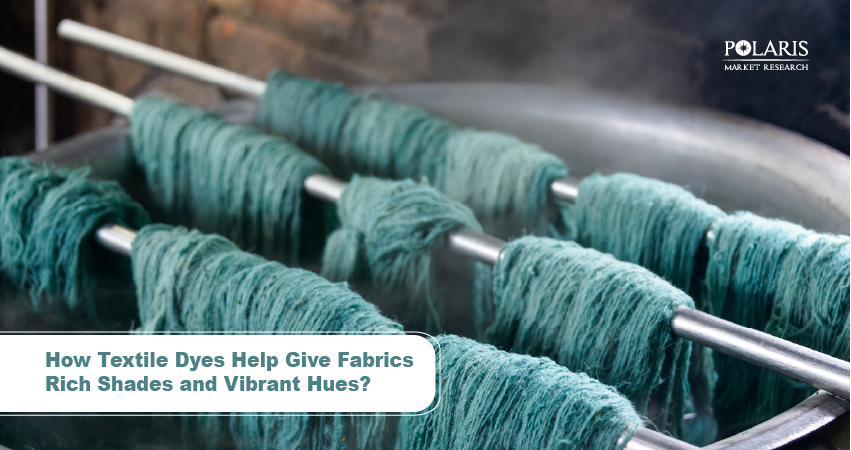How Textile Dyes Help Give Fabrics Rich Shades and Vibrant Hues?

Textiles are all around us. They make the clothes we wear and the home décor items we use. Textiles are used in the interior of various automobiles. They are also essential for various specialized items such as surgical blades and parachutes. Textiles are often dyed to improve their visual appeal. Dyeing also helps in improving the durability of fabrics.
In this blog post, we explain to you the basics of fabric dyeing. We cover the various methods used for dyeing textiles. We also detail the key metrics for the textile dyes market and the major factors shaping the market landscape. Continue reading!
A Quick Overview of Fiber Content
The choice of a specific dye type depends on the material that is being dyed. The characteristics of each fiber are unique. So, their interaction with the dye differs.
Natural Fibers
Natural fibers are obtained from natural sources. Cotton is a widely used natural fiber known for its absorbent properties. Dyeing cotton requires the use of a dye that penetrates the fibres effectively. Reactive dyes are widely used for cotton owing to their ability to bond with the fibers chemically. Silk is another popular natural fiber known for its softness and sheen. Acid dyes are typically used with silk as they can form an effective bond with protein-based fibers.
Synthetic Fibers
Synthetic fibers are made using polymers that don’t occur naturally. They are producing using petrochemicals and other chemicals. Polyester is a popular synthetic fiber that offers high durability and is resistant to wrinkles. Dyeing polyester typically involves the use of disperse dyes. Nylon is another widely used fiber type available in the synthetic fiber market. The ability of disperse dyes to withstand high temperatures makes them suitable for nylon. Basic dyes are used with acrylic, as they offer vibrant colors and improved colourfastness.
Textile Dyeing Explained
Textile dyeing is the process of adding color to textiles. Dyes are used to improve the attractiveness of textiles. They can also enhance the functionality of fabrics. Textile dyeing gives textiles their wide range of colors. It also ensures that both the aesthetic and practical requirements are met by these materials. With dyeing, artisans and manufacturers are able to transform plain fabrics into vibrant materials.
The dyeing process involves the application of colorants to yarns or fabrics. This helps in giving the material its desired hue. It’s possible to dye textiles at various stages during production. The selection of the specific dye type and dyeing method depends on various factors. These include the composition of the fabric and the expected color intensity, amongst others.
Major Textile Dyes Market Metrics
The market for textile dyes is expected to witness steady growth, according to our latest market analysis. The textile dyes market stood at USD 12.22 billion in 2024. It is projected to grow at a CAGR of 4.7% during the projection period.
The growing adoption of 3D printing to develop customized designs has led to increased demand for specialized dyes. Increased usage of environmentally friendly dyes is creating several textile dyes market opportunities.
Methods Used for Dyeing Textiles
Several methods can be used to dye textiles. Having an understanding of these techniques helps in the selection of the most apt method for a given fabric.
Vat Dyeing
Vat dyeing is a popular method for dyeing textiles. It immerses the fabrics in vats or large containers. The containers are filled with a dye solution. Vat dyeing goes well with dyes such as indigo. The colors produced with this method are deep and long-lasting. With vat dyeing, it’s possible to create rich hues on natural fibers.
Reactive Dyeing
In this method, a strong chemical bond is formed between the dye and the fiber. The colors obtained using reactive dyeing can resist fading and washing. Reactive dyeing is highly effective on natural fibers. The method is also used with fibers from the bio-based textiles market. Its use helps produce colors that are bright and long-lasting. The excellent colorfastness makes it useful for both home dyeing and industrial usage.
Direct Dyeing
This method of textile dyeing is quite simple. It involves the direct application of the dye to the fabric. Direct dyeing is easy to use and well-suited for materials such as cotton. However, it needs additional treatments to prevent the colors from fading over time. The straightforwardness of this process makes it popular for home dyeing and small-scale production.
Resist Dyeing
Resist dyeing is an innovative method for dyeing fabrics. Here, parts of the fabrics are treated to prevent the absorption of the dye. This helps in the creation of patterns or designs. Intricate designs can be produced using resist dyeing, making each piece unique. Materials such as paste and wax can be used as resists in this method.
Acid Dyeing
This method requires an acidic environment. The acidic conditions ensure that the dye bonds with the fabric. The colors obtained using the method are vibrant and long-lasting. Acid dyeing is especially suited for protein-based fibers, such as silk and wool. Its use is common with delicate fabrics as it can produce rich shades.
Solution Dyeing
This process involves the addition of the dye to the fiber solution before it is spun into yarn. That way, the colors get embedded in the fiber itself. The colors produced using this method can resist fading even if the fiber is exposed to sunlight or repeatedly washed. It is commonly used for fabrics that are exposed to outdoor elements, such as performance fabrics.
Final Words
Dyes are an important element of the textile world. They help give fabrics their rich shades and vibrant hues. Textile dyeing can also help in improving the functionality of the fabrics. The textile dyes market offers various types of dyes to meet the needs of different fabrics. In the coming years, we can expect to see market players introducing more advanced solutions to improve their market position.

